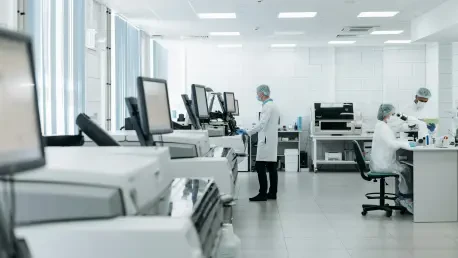The healthcare industry stands at a critical crossroads, where the interplay between innovation and intellectual property rights (IPRs) is under intense scrutiny. Recent legal conflicts, such as the one involving PointClickCare and its subsidiaries against CRISP, highlight crucial tensions within healthcare technology. This legal battle is not just about patent infringement but poses broader questions about how IPRs may inadvertently hinder technological advancements and business innovation. As healthcare continues to evolve rapidly, the need to navigate these challenges has never been more pressing. Firms that lead in pioneering technologies often need protection to safeguard their innovations, ensuring they retain a competitive edge and recuperate investment costs. However, stringent patent laws can sometimes create barriers to new entrants or even stifle further innovation by restricting access to essential technologies. This makes for a complex landscape where healthcare innovation and intellectual property rights must find a sustainable balance.
The Clash of Innovation and Intellectual Property
The recent lawsuit filed by PointClickCare against CRISP highlights the complex dynamics of intellectual property within the healthcare sector. Central to the dispute is PointClickCare’s claim that CRISP’s new technology, the CRISP Event Notification Delivery (CEND) system, infringes on patents associated with their Encounter Notification Services (ENS) solutions. This legal battle emphasizes the significant role IP plays in maintaining a company’s market position. ENS technology represents a leap in healthcare coordination, providing real-time alerts to healthcare providers upon patient admissions, discharges, or transfers. However, the alleged infringement by CRISP raises critical concerns about how proprietary technology is protected and the fine line between inspiration and imitation.
Beyond the immediate legalities, the clash underscores broader industry concerns. Developing groundbreaking healthcare technologies requires substantial investments, and intellectual property protection is crucial for companies to secure their innovations and encourage further advancements. Nonetheless, overprotection can deter other players from improving upon existing technologies, triggering debates on whether current IPRs obstruct industry progress. The ability of firms to mimic and adapt technologies while avoiding blatant patent violations is a focal point of contention, shaping the competitive terrain and influencing future regulatory policies.
Balancing Competition and Ethical Practices
The legal wrangling between PointClickCare and CRISP brings to light concerns about ethics and fairness in business competition. PointClickCare alleges that CRISP, through its CEND system, has executed unfair competitive practices, leveraging misappropriated technology for business advantage. Such accusations raise fundamental questions about the integrity of competition within the healthcare industry. PointClickCare contends that CRISP’s actions violate Maryland’s Unfair Competition Law, exacerbating ethical concerns around corporate conduct. In a sector as pivotal as healthcare, ensuring fair competition is essential to fostering innovation that benefits all stakeholders, from companies to patients.
Challenges presented by such legal disputes are not isolated. They reflect systemic issues within healthcare IT, where entities often find themselves entangled in multifaceted legal battles. Beyond mere protection of their innovations, companies need ethical frameworks to ensure equitable market behavior. Policymakers are frequently tasked with establishing guidelines that reconcile the need for both competitive fairness and effective innovation safeguarding. The outcomes of these disputes often set precedents that inform new regulations and practices, shaping the broader landscape of entrepreneurial conduct and the innovative environment in sectors reliant on rapid technological advances.
Broader Implications and Possible Solutions
The implications of the PointClickCare versus CRISP battle extend beyond patent infringements and unfair competition. This case underscores the ongoing tension between promoting innovation and ensuring robust legal standards that don’t hinder technological progress. Other legal conflicts, such as those faced by PointClickCare, amplify the complexities by adding layers of interpretation around data access and information sharing. The intersection of law, technology, and business in healthcare is a fertile ground for exploration, offering possibilities for reform and innovation. Legal tussles notwithstanding, they spur conversations around refining intellectual property laws to keep pace with rapid tech changes.
Ultimately, a solution may lie in reimagining how IPRs are granted and enforced. Adjusting patent durations, reevaluating the scope of protection, or even promoting open-access models might be avenues worth pursuing to encourage innovation without stifling competition. Moreover, collaboration between legal experts, technologists, and policymakers is vital to finding this balance. Forward-looking strategies could help create a healthcare ecosystem where innovation thrives, supported by fair practices and robust legal structures. The future of healthcare innovation hinges on achieving this equilibrium, ensuring that intellectual property rights protect without impeding the next big breakthroughs in the field.
Navigating the Future of Healthcare Innovation
The healthcare sector stands at a pivotal moment, where innovation and intellectual property rights (IPRs) are under significant examination. Recent legal disputes, such as the case involving PointClickCare against CRISP, underscore vital tensions within healthcare technology. This conflict extends beyond patent infringement and raises deeper issues concerning whether IPRs inadvertently impede technological progress and business innovation. As healthcare rapidly advances, it’s increasingly crucial to address these challenges. Leading companies in technology need IPRs to protect their innovations, ensuring a competitive edge and recovering their investments. Yet, rigorous patent regulations can hinder new market entrants and could even restrict further innovation by limiting access to vital technologies. This situation creates a complex environment where healthcare innovation and intellectual property rights must strike a sustainable equilibrium to foster continued progress, ensuring that advancements aren’t stifled by overly stringent regulations.









